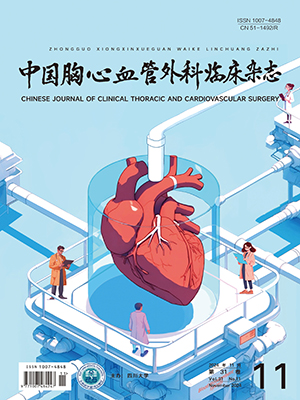Objective To compare clinical outcomes and safety between minimally invasive mitral valve replacement via right minithoracotomy (mini-MVR) and traditional mitral valve replacement (MVR). Methods Clinical data of 68 patients with valvular heart diseases who underwent mini-MVR from February 2009 to December 2011 in Wuhan Asia Heart Hospital were retrospectively analyzed. There were 36 males and 32 females in this mini-MVR group with their mean age of 34.2±11.2 years. Preoperatively, there were 21 patients with mitral stenosis (MS), 17 patients with mitral insufficiency (MI), 30 patients with MS and MI, and 19 patients with tricuspid insufficiency (TI). Another 200 patients with valvular heart diseases who underwent traditional MVR during the same period were included as the control group. There were 86 males and 114 females in the control group with their mean age of 49.4±13.2 years. Preoperatively, there were 85 patients with MS, 66 patients with MI, 49 patients with MS and MI, and 76 patients with TI. Hospital mortality, aortic crossclamp time, length of intensive care unit (ICU) stay, postoperative chest tube drainage, reexploration for bleeding and postoperative morbidities were compared between the two groups. Results There was no in-hospital death in the mini-MVR group. There was no statistical difference in hospital mortality, cardiopulmonary bypass time, incidence of reexploration for bleeding, postoperative arrhythmias, dialysis-requiring acute renal failure and wound infection between the two group (P>0.05). Aortic crossclamp time of the mini-MVR group was significantly longer than that of the control group. But postoperative mechanical ventilation time (10.2±3.1 h vs. 15.2±7.1 h, P=0.008), chest tube drainage(92.0±28.0 ml vs. 205.0±78.0 ml, P=0.000), blood transfusion (0.8±1.6 U vs. 1.9±2.1 U, P=0.006), length of ICU stay (14.0±8.0 h vs. 26.0±12.0 h, P=0.003) and length of hospital stay (14.8±4.6 d vs. 19.7±3.2 d, P=0.006)of the mini-MVR group were significantly shorter or less than those of the control group. Conclusion The safety of mini-MVR is comparable to that of traditional MVR without causing higher postoperative morbidities, while the postoperative recovery after mini-MVR is better than traditional MVR.
Citation: WANG Xiao,TAO Liang,CHEN Xufa,YU Huadong,FENG Xueguo,FU Jun.. Comparison between Minimally Invasive Mitral Valve Replacement via Right Minithoracotomy and Traditional Mitral Valve Replacement. Chinese Journal of Clinical Thoracic and Cardiovascular Surgery, 2013, 20(2): 139-143. doi: 10. 7507/1007-4848. 20130045 Copy




